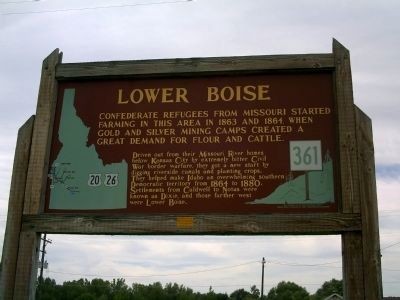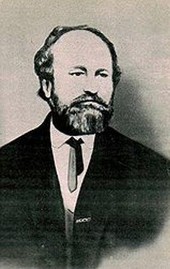Lower Boise Historical Marker-Confederates in Idaho
Introduction
Text-to-speech Audio
Images
Lower Boise Marker

David W. Ballard, 3rd Governor of Idaho Territory, who clashed with the overwhelmingly Democratic and pro-Confederate territorial legislature.

Backstory and Context
Text-to-speech Audio
History of the Confederacy in Idaho
The Idaho Territory was created on March 4, 1863, and similar to the political construction of other U.S. Territories at the time, the Idaho Territory government was headed by a federally appointed governor as well as a territorial secretary. In terms of politics and law, the Idaho Territory Supreme Court justice was federally appointed; the territorial legislators, as well as nonvoting delegates to the U.S. Congress, were chosen by popular elections.
Since the Idaho Territory was established during the tumult of the Civil War, it was marred by the partisan strife typical of many states at that time. Furthermore, the Oregon Trail had become safe for travel, and Idaho was experiencing its prosperous mining boom. Beginning in 1863, thousands of Confederate refugees sought to escape the horrors of war by heading to the Pacific Northwest. Many left their homes in Missouri just below Kansas City, as extremely bitter border warfare left widespread bloodshed and massacre. Also, Confederate deserters, draft dodgers, and many others throughout the south looking to escape the war joined in this large migration on the Oregon Trail.
By the war's end, southern Idaho and the Boise Basin were controlled by Confederates. Lincoln and his adherents controlled the first hierarchies of government, but, as noted from above, legislation was Democratic with southern sympathies. These roots could be seen in the Elmore County town of Dixie, the Boise County community of Confederate Gulch, the Canyon County town of Dixie, the Boise County area known as Grayback Gulch, and many others.
Regarding the situation, Idaho historian Carlos Schwantes wrote, “In many ways, Idaho was as much Confederate as Union territory. Its remote location coupled with the appeal of mining camp bonanzas made it a haven for people on both sides who sought to escape the horrors of war.”1
Inscription on the Historical Marker
Confederate refugees from Missouri started farming in this area in 1863 and 1864 when gold and silver mining camps created a great demand for flour and cattle.
Driven out from their Missouri River homes below Kansas City by extremely bitter Civil War border warfare, they got a new start by digging riverside canals and planting crops. They helped make Idaho an overwhelming southern Democratic territory from 1864 to 1880. Settlements from Caldwell to Notus were known as Dixie, and those farther west were Lower Boise.2
Cite This Entry
Admin, Clio. "Lower Boise Historical Marker-Confederates in Idaho." Clio: Your Guide to History. January 31, 2016. Accessed April 1, 2025. https://theclio.com/entry/21447

